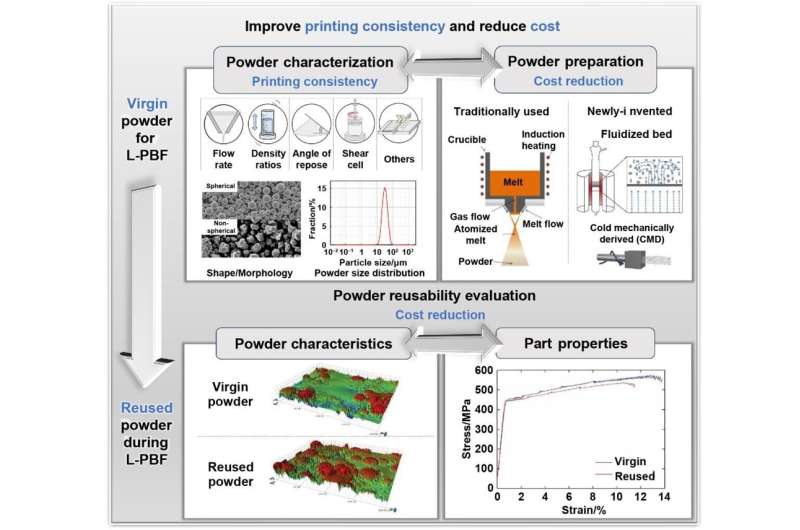This article has been reviewed according to Science X's editorial process and policies. Editors have highlighted the following attributes while ensuring the content's credibility:
fact-checked
proofread
Metallic powders: Paving the way for industrial applications of laser powder bed fusion

Scientists from Nanjing University of Science and Technology (NJUST) have reviewed the recent progress in the characterization, preparation, and reuse of metallic powders for laser powder bed fusion (L-PBF), which can pave the way for the broad industrial applications of L-PBF by enhancing printing consistency and reducing the total costs from the perspective of powders.
This research, published in the International Journal of Extreme Manufacturing, shows the recent progress in the characterization, preparation, and reuse of metallic powders for L-PBF.
L-PBF has redefined the manufacturing field since its inception due to its design freedom. However, there are several hurdles that prevent the extensive applications of L-PBF, including the printing consistency and high fabrication costs, which are directly related to the metallic powder feedstock. Thus, powder characterization, preparation, and reuse are vital to boost the L-PBF technology.
Several cost-effective methods, such as the fluidized bed, cold mechanically derived method, and powder mixing, have emerged to prepare the powders instead of the atomization method.
Furthermore, powder reuse is a commonly implemented manner to enhance powder use efficiency. However, no previous work has discussed the promotion of L-PBF from the above-mentioned perspectives in spite of their importance. To fill this gap, the present work reviews the recent progress in the characterization, preparation, and reuse of metallic powders.
"Powder characterization, which reflects the particle size distribution, flowability, and chemical composition, is critical to evaluate whether the powders are out of specification, guaranteeing the reliability and repeatability of the fabricated parts," said Xiaoyu Sun (Ph.D candidate now at Nanjing University of Science and Technology), the co-first author on this paper.
"To lower the total costs of L-PBF concerning powder usage, focus can be directed towards either optimizing powder preparation or improving powder usage efficiency. As the mainstream for powder preparation, gas atomization shows disadvantages of high cost and low yield ratio," said Minan Chen (Master candidate now at Nanjing University of Science and Technology), the co-first author on this paper.
"To meet this end, novel powder preparation methods, such as the fluid bed and cold mechanically derived method, have emerged to prepare the powders in a cost-effective manner, reducing the powder preparation cost."
"Moreover, utilizing powder mixing for preparation offers a convenient approach to develop powders with novel compositions, eliminating the need for atomization for each unique composition."
During the L-PBF process, only a fraction of powders that have been spread are used for constructing the component, while the rest of powders remain on the building plate or are carried into the overflow tank. Maximizing the usage efficiency for these powders which have undergone powder degradation due to laser-particle interaction is critical to reduce the total costs of L-PBF.
Prof. Zhiguang Zhu, a professor of mechanical engineering at the Nanjing University of Science and Technology as well as the senior author on this study commented, "We have systematically reviewed the effect of powder reuse on the powder characteristics and properties of L-PBF printed parts on the workhorse materials, such as steels, titanium and titanium alloys, nickel-based superalloys, and aluminum alloys, as well as less-frequently investigated alloys, such as the Co-Cr alloys and high entropy alloys."
"The results hitherto indicate that the evolution trend differs among different alloy systems due to multiple variables involved in the whole printing process. For instance, the chemical and mechanical properties of Ti6Al4V and Al alloys are more susceptible to powder degradation relative to that of steels and nickel-based superalloys."
With the merits of design freedom and producing small lot sizes, L-PBF has enjoyed popularity for manufacturing products with a high degree of functionality in the fields of aerospace and medical fields. To gain broader industry momentum, enhancing the printing consistency and reducing the total costs are essential, which can be achieved via powder characterization, preparation, and reuse.
"In addition to the discrete element method (DEM), future work could be done by exploring more numerical simulation methods to understand powder characteristics. Due to the high price of metal powder preparation, it is necessary to optimize the existing powder preparation technologies or explore novel and cost-effective powder preparation methods," said Professor Tingting Liu (professor of mechanical engineering at the Nanjing University of Science and Technology), the corresponding author on this paper.
"With the rapid development of alloy systems that can be processed via L-PBF, it is necessary to evaluate the powder reusability of these newly-emerged alloys. Exploring the powder reuse protocol to ensure that the powders do not fall out of specification and the properties of L-PBF components are within the standard for industrial applications, which can pave the way for the broader applications of L-PBF."
More information: Xiaoyu Sun et al, Characterization, preparation, and reuse of metallic powders for laser powder bed fusion: a review, International Journal of Extreme Manufacturing (2023). DOI: 10.1088/2631-7990/acfbc3




















